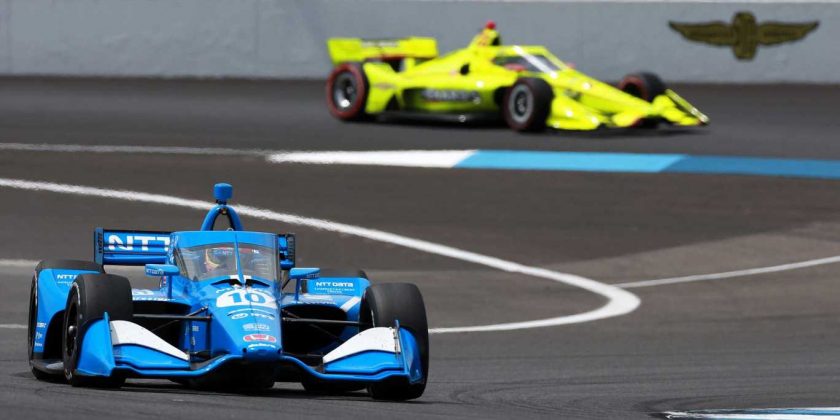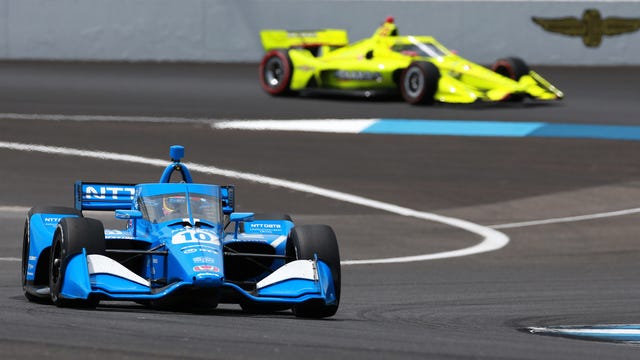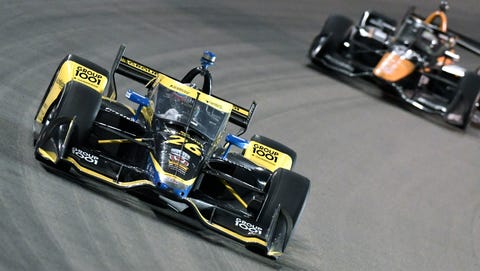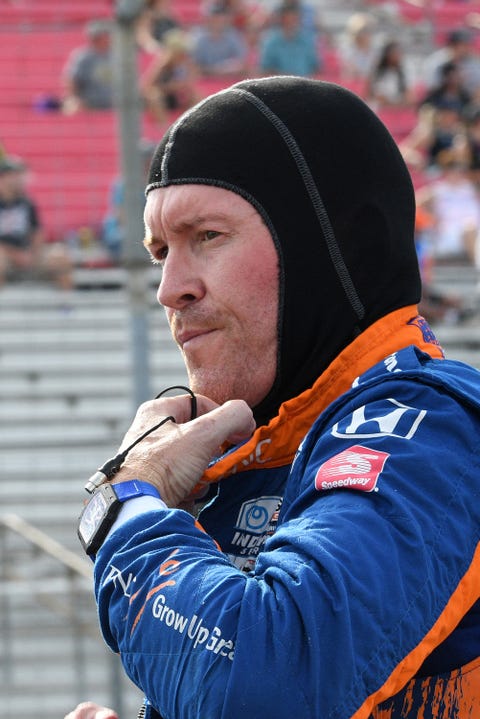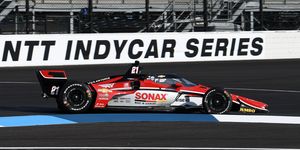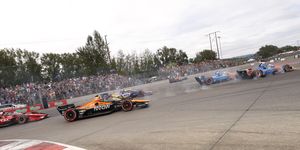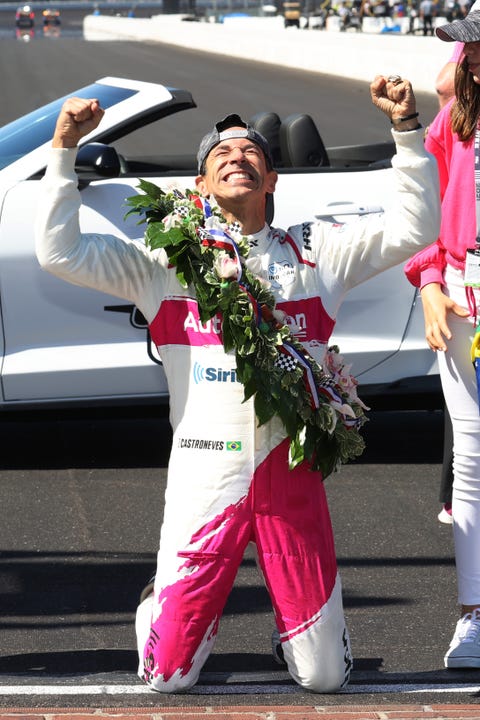The 2021 IndyCar season is just about over. Only Sunday’s Acura Grand Prix of Long Beach remains, with just three drivers left in contention for the season championship: Alex Palou, who has a hefty 35-point lead over Pato O’Ward, and two-time champ Josef Newgarden a distant third.
In addition to all the full-time drivers that have taken part in the season, one other man has been there for virtually every race, practice and qualifying session, namely NBC lead IndyCar anchor, Leigh Diffey.
Celebrating his 25th year in TV and his ninth consecutive season as the voice of IndyCar on the tube, the Australian native has had a front row seat to all the action this season.
In an exclusive interview with Autoweek, Diffey, 50, said this season has been more than just another campaign. He said the 2021 season will go down in history as a changing of the guard, where several young drivers such as Palou, O’Ward and IndyCar newcomer Romain Grosjean are not only making their mark, they’re on the verge of overtaking some of the sport’s most celebrated past champions and successful veterans.
“This is going to be a season that we remember for a long time,” Diffey told Autoweek. “To me, it’s a pivotal season. You can talk about a changing of the guard, new blood in the sport, a fresh look or however you want to tag it or phrase it, but this is that year.
“These youngsters haven’t just come to the series, they’ve come to the series and they’re winning, and they’re stamping their authority. They’re saying, ‘we’re here and we’re not here just to make up the numbers, we’re going to take on the Dixons and the Hunter-Reays and the Bourdais and whomever else you want to name.
“Alex Palou, Pato O’Ward, Colton Herta and Romain Grosjean, even though he’s in his 30s, the new fresh look of IndyCar is here. To me, it’s been a season that’s so full of fruit because we’ve still got the veterans and the legends. And then you’ve got this young new group, that fresh new group that are either second-year drivers or rookies like Scott McLaughlin. It’s been a great addition to the series.
“These rookies, second- or third-year drivers have come to play, and they’ve come to play up against the biggest names in the sport. So for us as fans and viewers, I think it’s been a home run, it’s been a win-win. We can’t lose this year. It’s been awesome.”
When asked whether he can recall a season where so many young drivers had such a major impact upon the sport, Diffey said not in his nearly decade of calling IndyCar races.
“New drivers come and go but they may not always be impactful, how well do they actually perform when they arrive?” Diffey said. “These guys like Palou, two years ago he was sitting in Japan saying, ‘I’d really love to go and drive IndyCar,’ and now he’s on the verge of being a champion.
“I can’t remember one (season) that has been like this because typically, IndyCar has done a good job at giving many drivers a long tenure, Scott Dixon, Tony Kanaan, Ryan Hunter-Reay, Sebastien Bourdais, Takuma Sato, the list goes on. These guys have been around a long time. But to get this injection of younger drivers that are that good, that fast, that aggressive, I think that’s why this year is going to be memorable. I think 2021 has just been magnificent.”
“I think 2021 has just been magnificent.”
As for comparing what went right and what went wrong the most this season, Diffey looked back at the difficult campaign the series had in 2020 due to the COVID-19 pandemic, including so many cancelled or rescheduled races, as well as running the Indianapolis 500 in August rather than on May, and without any fans in the stands, and then looked at how the series came back to have an almost normal season in 2021 as it had prior to the pandemic.
“I’m not being a cheerleader, but I don’t think there was a whole lot that went wrong, especially how they came back from last year, because last year was just so difficult,” Diffey said. “And right at the top was Roger Penske and Penske Entertainment and (IndyCar president) Jay Frye.
“Their commitment to standing up and saying ‘we are going to have fans at the Indianapolis 500’ and made that call early. They worked with the local government and local authorities and they just stayed true to their commitments. We were all told there’d be 135,000 people on site, but it really felt like there was about 200,000 people there. And it was magnificent, it was fantastic. I think my line coming to the green flag, as we looked out (at the green flag), I said, ‘The soul is back at the Speedway,’ and it was.”
But there was a downside to the season, as well. Veterans, including many past champions such as defending and six-time champ Scott Dixon, struggled. Dixon won just one race this season, only the second time he won just once in a season overall since 2005. That lack of success led to Dixon being eliminated from the championship battle last weekend at Laguna Seca.
Others having uncharacteristically rough years included Graham Rahal (winless for the fourth straight year), Will Power (just one win), and winless seasons for several drivers including Simon Pagenaud, Takuma Sato, Ryan Hunter-Reay, Sebastien Bourdais and James Hinchcliffe.
And perhaps the biggest disappointment and surprise at his lack of success has been Alexander Rossi, currently winless and in 10th place heading to Long Beach.
But there’s a reason for many of the veterans coming up short: the sport has just become so competitive and close that one “blip,” as Diffey says, can truly be the difference between a good day and a mediocre day.
“You have a look at the margin from whoever was quickest and more often than not, it’s less than a second,” Diffey said. “Sometimes it’s half a second between first and 15th. What? That’s crazy! On paper, it looks bad, but it’s not, they’re just a blip off. And if you’re a blip off, you’re back in 13th or 18th. It’s so competitive and for the new people in the series, it’s tough to take.”
But age can also be a factor, Diffey added.
“For some of those guys, it’s not great because they’re not winning or they’re not getting podiums,” he said. “Sometimes I kind of want to defend them because I don’t think it’s always as bad as what it looks. But also keep in mind that when you’re either 40 or in your early to mid-40s, like we have several drivers in that situation, are they driving at 45 like they did when they were 25, with the same level of commitment when they’ve got families, wives, children, etc.
“You know, I think as time goes on, we can’t help it as humans, but somebody who’s in their mid-40s is not going to be as aggressive as Pato O’Ward or Colton Herta. Time is the enemy there.”
IndyCar has had a number of high points this season, most notably Helio Castroneves’ emotional fourth career win in the Indianapolis 500, tying him with Rick Mears, A.J. Foyt and Al Unser for most wins in the Greatest Spectacle In Racing.
Not only was it the high point in Castroneves’ career, it also was such for Diffey, as well. But there was also more for Diffey, including being part of the NBC team at the Summer Olympics in Japan, where he called the track and field competition.
“The way that Helio Castroneves has won his fourth Indy 500 and after he crossed the yard of bricks, that was one of the greatest pieces of natural live sporting theater that I’ve ever seen and I was thrilled to be able to call his fourth win,” Diffey said. “And then to do track and field at the Tokyo games. You know, this has been the year of my career. And even though it is a lot of work, it’s a lot of hard work and dedication and preparation, etc., but it’s been the most rewarding year of my career.”
It’s been a longer year than usual for Diffey. One might think that after Sunday, his broadcast year is done. Wrong, it’s not. He goes to Texas next week to announce a MotoGP race.
“I’m keeping my foot on the gas,” Diffey said with a laugh.
Follow Autoweek correspondent Jerry Bonkowski on Twitter @JerryBonkowski
Source: Read Full Article
